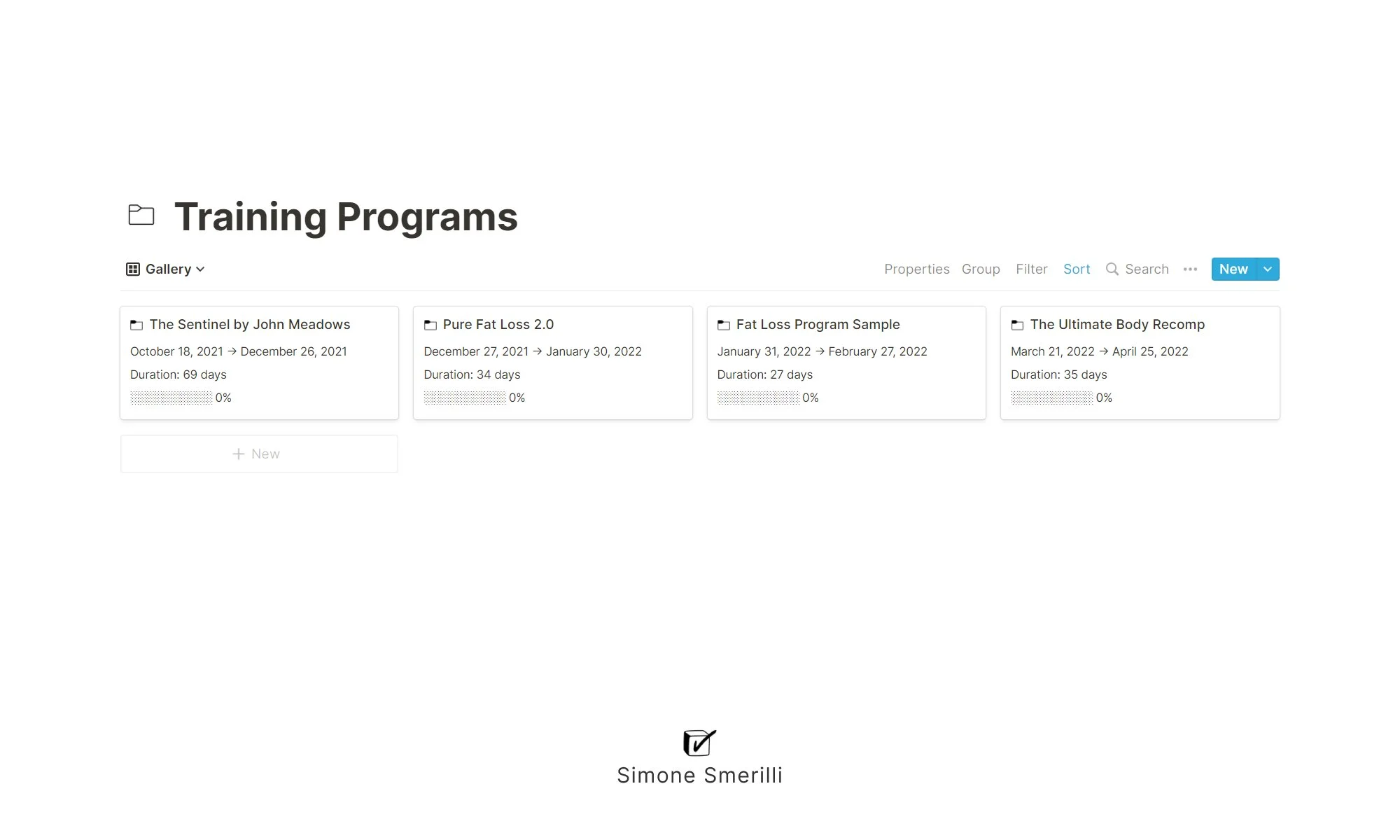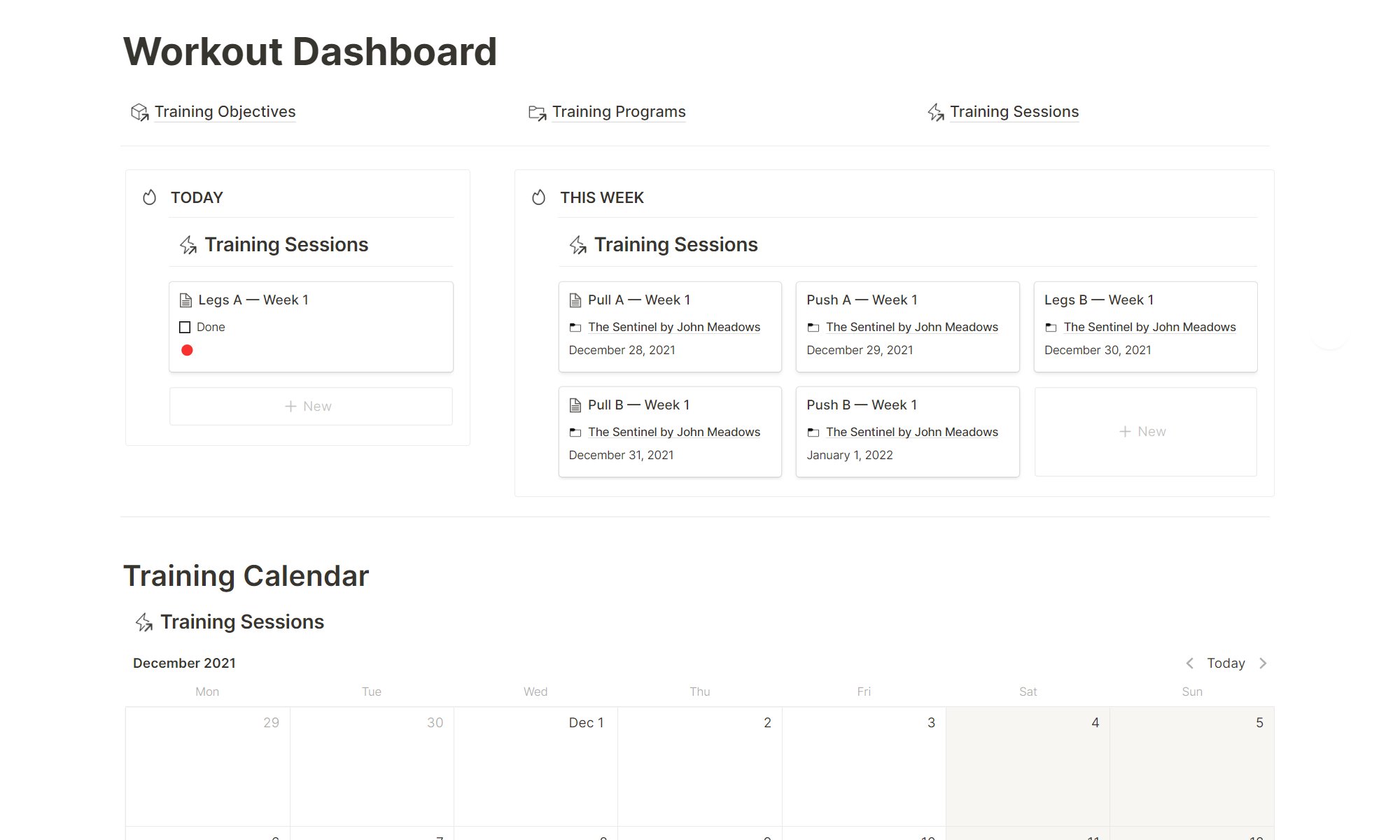Notion Workout Planner & Tracker - Colossus
A comprehensive workout tracking system is composed of multiple layers. There are several levels of resolution, starting from the highest—your fitness objective—cascading down to the single exercises included in each training session. In between those two extremities, there exist other levels: training programs, training sessions. Every training session is composed of one or multiple movements. Every training program is composed of multiple training sessions. Every fitness/health objective is linked to one or multiple training programs. When you break down the training process in a systematic way, you can start to see the path forward. You devise a plan. And plans can make the difference between doing and not doing; becoming and not becoming; feeling good and not feeling good. Being consistently good is better than being occasionally great. Especially in the game of fitness and training. A system makes it more likely that you are consistently good. This Notion workout tracking system aims at just that: optimizing consistency and achieving your fitness objectives, all in one place.
Fitness Objectives
The more specific and realistic you are with your fitness objective, the more likely you will achieve it; the higher the chance of long-term success. Fitness objectives are no different than general goal setting. Be precise, even though it may often feel frightening to be precise. Being precise in the definition of your goal implies that you will become conscious of your failure, in case of a negative outcome. There is a trade-off here: is it more important to set specific goals, hence winning big or losing big, or is it better to remain politically correct in fitness objectives, so that the process of failure feels less painful? Is your short-term identity more important than long-term changes and lifestyle optimization?
The worst-case scenario when failing to reach an objective is—might be—being conscious of failure and decreasing your self-esteem—your perceived self-esteem. Or you may reinvent the wheels and get rid of identity perceptions. You may view yourself as a start-up. You are a start-up. Start-ups do not—cannot—fear short-term failure. “Failing fast” is almost considered an admirable trait in that ecosystem. If you want to innovate, you cannot fear failure. Failure is an integral component of innovation, similar to how a training session is a component of a training program. Attaching your identity to “the type of person who does not make mistakes” may turn out to be a toxic recipe for mediocrity. There is nothing wrong with being mediocre. But change for the better cannot—need not—happen through mediocre behavior. There needs to be an intrinsic call to action. A drive to innovate, fail, iterate, get back on your feet, improve, achieve, let go of identification with the outcome. You are not your next thought. You may be your next action.
Workout Programs
Objectives are not enough; necessary, but not sufficient. Similar to the Goal Setting system, also in fitness, objectives need to be broken down into actionable items. In the fitness case, workout programs are the next level of resolution after objectives. A fitness objective may be represented by wanting to—intending to—hold a free handstand for five seconds, or losing ten pounds of visceral fat in two months. Objectives need to be realistic and specific. So need to be workout programs. Programming is a science and art. There has to be a progressing component built into the training programs you follow.
Programs are composed of multiple training sessions. A training program may last from two weeks to three months (this is a generic statement—not universally valid). The duration of a workout program also depends on your training ability and experience level. When you are a beginner trainee, you may run the same program for more than two months, until progress on the main exercises stalls. This is usually not the case for advanced athletes, whose body requires more variation and hence shorter-lived programs. Changing training program is also a manifesto for variety. Especially in the resistance training environment, it appears that doing the same exercises for a prolonged period of time feels boring to many people. This may be one of the reasons why CrossFit is so popular around the world. A workout program, broadly speaking, cannot be too short—e.g., less than one month—unless you care more about variation and fun than optimizing your key performance indicators. There must be an improvement over time. Improvement comes with consistent repetition of the same movement for a certain time frame. Training must be enjoyable in order to be sustainable. So, striking a solid balance between metrics optimization and variety is key.
Training Sessions
As already hinted, each training program is composed of multiple sessions. A session is composed of multiple movements. The goal of a training session is to advance toward the higher objective (or simply enjoy the process). Every training session is vitally important to achieving the objective. However, it may not feel that way. Training sessions are the process. Being consistent in the journey pays off in the long term. Showing up at each workout session, even when you don’t feel at your top energy levels, has compound effects over time. This is the power of habits. In our Notion workout planner and tracker, training sessions are shown in a calendar, as well as in the centralized dashboard, where the current week’s sessions are displayed in a pipeline. A calendar view is best for planning and visualizing the big picture of training sessions. A pipeline view is best for consistent, deliberate, focused action.
Movements
Ultimately, the smallest step you can take in achieving the fitness objective is moving. Performing an exercise, whatever its nature. Whether bodyweight or weight-resisted, movements are part of a training session. Completing a set of movements concludes a training session. There is value in keeping track of progress on compound movements over time. Compound movements are those exercises targeting multiple muscle groups at once (e.g., squats, deadlifts, bench press, pull-ups, push-ups). Because of their compound nature, they can be progressed over time more easily compared to isolation movements/skills. The workout tracking Notion template focuses on that—tracking progress over time—at the movement level. There is no comparison over time for the same exercise. You can only review your progress by browsing through your history of training sessions. Like in an analog workout tracker you likely would have used until the first years of the last decade. The core focus of a workout management system is providing a plan of action, a clear path toward achieving a goal—or just training for the sake of it. Being consistently good will ensure progress over time, especially if you are at the beginning phase of your fitness journey.
Our new Notion workout management system includes a database of core weighted and bodyweight exercises, divided by body part, with links to their execution. This is just reference material, that you may find useful when choosing the most effective movements for your training program.
The Fitness Tracker Notion System
This workout planning and tracking Notion system collects all of the concepts explained above in one place. Everything is linked harmoniously for an effective organization of content. Contextual dashboards make it possible to visualize information where it matters. A central dashboard displays this week’s training sessions and a calendar for planning the next week and reviewing past weeks. Ultimately, taking action matters most. A system can make it smooth to take action and remove the uncertainty of planning. When you know the movements to perform today, cognitive effort is removed from the equation. Execution is the only element left, and it is what makes the difference.






